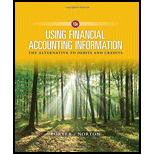
Concept explainers
Revenue Recognition
The highway department contracted with a private company to collect tolls and maintain facilities on a turnpike. Users of the turnpike can pay cash as they approach the toll booth, or they can purchase a pass. The pass is equipped with an electronic sensor that subtracts the toll fee from the pass balance as the motorist slowly approaches a special toll booth. The passes are issued in $10 increments. Refunds are available to motorists who do not use the pass balance, but they are issued very infrequently. Last year, $3,000,000 was collected at the traditional toll booths, $2,000,000 of passes were issued, and $1,700,000 of passes were used at the special toll booth. How much should the company recognize as revenue for the year? Explain how the revenue recognition rule should be applied in this case.
Concept Introduction:
Profit is calculated by reducing all the expenses from the total income of the company. All expenses include the cost of goods sold, administration expenses, selling expenses and some other expenses. Revenue is recorded when business earn it not when it recovers from customer.
To Explain: Amount of revenue and rule of revenue recognition.
Explanation of Solution
Company record revenue of $ 4700000 (3000000+1700000) and refund of $ 300000 (2000000-1700000) made to the customer against the passes not used. Revenue is recorded when it earns. So in this case all income received in cash is recorded as income and all passes that used on toll is also recorded as income but those passes which cannot be used is refunded to the customer.
Want to see more full solutions like this?
Chapter 4 Solutions
Using Financial Accounting Information
- How much intrest bank collect?arrow_forwardRequired information Skip to question [The following information applies to the questions displayed below.]XYZ declared a $1 per share dividend on August 15. The date of record for the dividend was September 1 (the stock began selling ex-dividend on September 2). The dividend was paid on September 10. Ellis is a cash-method taxpayer. Determine if he must include the dividends in gross income under the following independent circumstances. b. Ellis bought 100 shares of XYZ stock on August 1 for $21 per share. Ellis sold his XYZ shares on September 5 for $23 per share. Ellis received the $100 dividend on September 10 (note that even though Ellis didn’t own the stock on September 10, he still received the dividend because he was the shareholder on the record date).arrow_forwardHow much overhead applied over this year?arrow_forward
 Financial Accounting: The Impact on Decision Make...AccountingISBN:9781305654174Author:Gary A. Porter, Curtis L. NortonPublisher:Cengage Learning
Financial Accounting: The Impact on Decision Make...AccountingISBN:9781305654174Author:Gary A. Porter, Curtis L. NortonPublisher:Cengage Learning

